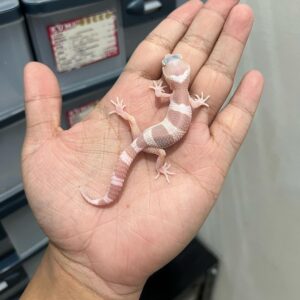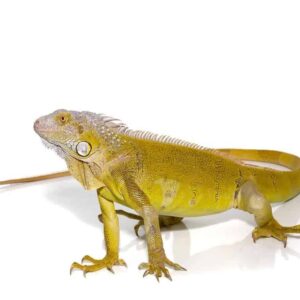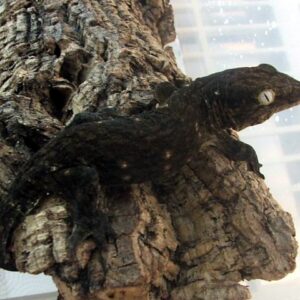Snowflake Nu Ana Leachianus Gecko For Sale
$349.99
WE HAVE SNOWFLAKE NU ANA LEACHIANUS GECKO FOR SALE. HERE ARE SOME HIGHLIGHTS:
- Rhacodactylus leachianus
- Captive Bred Baby
- Approximately 3 Inches From Snout To Vent
- Adults Can Grow Upwards Of 12 – 14 Inches From Head To Tail
- Feeding On Pangea Crested Gecko Diet And Crickets
Description
The Snowflake Nu Ana Leachianus Gecko, often revered for its striking appearance and unique characteristics, has captivated reptile enthusiasts around the globe. Originating from the remote Nu Ana Island, part of the New Caledonian archipelago, this gecko species boasts an impressive array of features that distinguish it from other gecko species. Its adaptability to various environments and its intriguing physical traits make it a fascinating subject for herpetologists and hobbyists alike.
One of the most distinguishing characteristics of the Snowflake Nu Ana Leachianus Gecko is its unique ‘Snowflake’ pattern. This pattern manifests as a series of white spots and blotches scattered across its body, reminiscent of snowflakes. The contrast between these white markings and the gecko’s typically darker base color creates a visually stunning effect, making this species highly sought after in the pet trade.
Physically, the Snowflake Nu Ana Leachianus Gecko is robust and relatively large compared to other gecko species. Adult individuals can reach lengths of up to 14 inches, including their tail. Their skin texture is notably rough, a feature that aids in camouflage among the rugged terrains of their native habitat. Additionally, their prehensile tails and strong limbs equipped with adhesive pads allow them to navigate and cling to various surfaces with ease.
The origin of the Snowflake Nu Ana Leachianus Gecko adds another layer of intrigue. The isolation of Nu Ana Island has contributed to the development of this gecko’s unique traits, as the species evolved distinct characteristics to adapt to its specific environmental conditions. The ‘Snowflake’ pattern, for example, may have evolved as a form of disruptive coloration, aiding in their survival by breaking up their outline against the island’s rocky landscape.
Overall, the Snowflake Nu Ana Leachianus Gecko’s combination of unique physical attributes and captivating patterns make it an extraordinary example of evolutionary adaptation and aesthetic appeal within the reptile world. This introduction sets the stage for a deeper exploration into the care, behavior, and conservation of this remarkable species.
Habitat and Natural Environment
The Snowflake Nu Ana Leachianus Gecko, native to the remote islands of New Caledonia, thrives in a unique and specific habitat that significantly influences its behavior and lifestyle. New Caledonia, an archipelago in the Southwest Pacific, is characterized by a tropical climate with seasonal variations that play a critical role in the gecko’s life cycle. The region experiences hot, humid summers and cooler, drier winters, which dictate the gecko’s activity patterns and reproductive cycles.
The vegetation in New Caledonia is diverse, ranging from dense rainforests to dry sclerophyll woodlands. The Snowflake Nu Ana Leachianus Gecko primarily inhabits the canopy layers of these forests, where it can find ample cover and food resources. The lush, leafy environment provides an abundance of insects and other small invertebrates, which constitute the gecko’s primary diet. Additionally, the thick foliage offers protection from predators and harsh weather conditions, ensuring the gecko’s survival in its natural habitat.
Another critical aspect of the Snowflake Nu Ana Leachianus Gecko’s habitat is the presence of large, mature trees. These trees are essential for the gecko’s arboreal lifestyle, providing not only food and shelter but also opportunities for territorial displays and mating. The gecko’s ability to blend into the tree bark with its camouflaged skin patterns further aids in avoiding predators and capturing prey.
Environmental conditions such as temperature, humidity, and light cycles directly influence the gecko’s behavior. The gecko is primarily nocturnal, becoming more active during the cooler, more humid nights. This nocturnal activity helps it avoid daytime predators and extreme temperatures, ensuring its survival in the challenging conditions of New Caledonia’s forests.
In summary, the Snowflake Nu Ana Leachianus Gecko’s habitat in New Caledonia is a complex and dynamic environment. The tropical climate, diverse vegetation, and presence of mature trees create an ecosystem that supports the gecko’s unique behaviors and lifestyle. Understanding these natural conditions is vital for anyone interested in the conservation and study of this fascinating species.
Diet and Feeding Habits
The Snowflake Nu Ana Leachianus Gecko exhibits a diverse and adaptable diet, reflecting its natural habitat in the wild. As an omnivorous species, these geckos consume a variety of food sources, which play a crucial role in their overall health and well-being. Primarily, their diet consists of insects, small invertebrates, and fruit. This varied diet not only satisfies their nutritional needs but also complements their hunting and foraging instincts.
In their native environments, Snowflake Nu Ana Leachianus Geckos actively hunt for live prey, such as crickets, beetles, and moths, leveraging their keen senses and agile movements to capture these insects. Their penchant for live prey ensures they receive the necessary proteins and other essential nutrients. Additionally, these geckos consume a variety of fruits, including figs, bananas, and berries, which provide vital vitamins, minerals, and fiber essential for their digestive health.
One notable aspect of the Snowflake Nu Ana Leachianus Gecko’s dietary habits is their propensity to feed on nectar and pollen. This behavior is not only beneficial for the geckos but also plays a part in the pollination of certain plant species, demonstrating a symbiotic relationship with their environment. Furthermore, these geckos have been observed to exhibit nocturnal feeding behaviors, which likely evolved to avoid daytime predators and take advantage of cooler temperatures.
When in captivity, replicating the gecko’s natural diet is crucial. A balanced diet for a captive Snowflake Nu Ana Leachianus Gecko typically includes a mix of commercially available gecko food, live insects like crickets or mealworms, and fresh fruits. It’s important to provide a variety of food items to ensure their dietary requirements are met. Additionally, calcium and vitamin D3 supplements are often recommended to maintain strong bones and overall health.
Understanding the diet and feeding habits of the Snowflake Nu Ana Leachianus Gecko is essential for both enthusiasts and researchers. By emulating their natural dietary patterns, we can ensure these unique creatures thrive in both wild and captive environments.
Physical Characteristics and Morphology
The Snowflake Nu Ana Leachianus Gecko is renowned for its unique and captivating physical characteristics. One of the largest gecko species, adults can reach lengths of up to 14-17 inches, making them a prominent member of the gecko family. Their robust and muscular build is complemented by a relatively short and thick tail, which serves as a vital fat storage organ, crucial for survival during scarce food periods.
A defining feature of this species is its distinctive coloration and pattern. The term ‘Snowflake’ refers to the intricate, pale patterns that adorn their typically dark or muted background skin tone. This pattern resembles scattered snowflakes, giving the gecko an ethereal appearance. The coloration can vary significantly among individuals, ranging from shades of grey, brown, or green, interspersed with white or cream spots.
The skin texture of the Snowflake Nu Ana Leachianus Gecko is another notable attribute. It is relatively smooth but interspersed with small, granular scales, providing a tactile quality that aids in camouflage. This combination of texture and pigmentation allows the gecko to blend seamlessly into its natural habitat, which includes the bark of trees and rocky crevices, offering protection from predators.
Furthermore, the gecko’s morphology is adapted to its arboreal lifestyle. It possesses large, adhesive toe pads that facilitate climbing and maneuvering through the dense foliage of its native environments. These toe pads are equipped with microscopic hair-like structures called setae, which create van der Waals forces, enabling the gecko to adhere to various surfaces effortlessly.
Despite the consistency in general features, there is a degree of individual variation among Snowflake Nu Ana Leachianus Geckos. Factors such as age, diet, and environmental conditions can influence their size, coloration, and pattern intensity. These variations not only add to the species’ allure but also underscore the adaptability and resilience of these remarkable reptiles.
Behavior and Temperament
The Snowflake Nu Ana Leachianus Gecko exhibits a fascinating array of behaviors and a distinctive temperament that sets it apart from other gecko species. These geckos are known for their nocturnal activity patterns, becoming most active during the night. During the day, they typically seek refuge in shaded areas or crevices, conserving energy and avoiding predators. Their nocturnal nature makes them excellent climbers, utilizing their adhesive toe pads to navigate vertical surfaces with ease.
Socially, the Snowflake Nu Ana Leachianus Gecko displays a range of interactions that are both intriguing and complex. Unlike some gecko species that prefer solitude, these geckos can exhibit social behaviors, particularly in captivity. They communicate through a series of vocalizations, including clicks and grunts, which serve as a means of establishing territory and signaling distress or mating intentions. However, it is essential to monitor their interactions closely, as territorial disputes can arise, especially among males.
One unique behavior observed in the Snowflake Nu Ana Leachianus Gecko is its ability to form bonds with its human caretakers. Over time, with consistent and gentle handling, these geckos can become relatively tame, showing a level of trust and recognition that is uncommon in reptiles. This attribute contributes significantly to their popularity among reptile enthusiasts and makes them a rewarding pet for those willing to invest time in their care.
Moreover, the Snowflake Nu Ana Leachianus Gecko’s behavior is influenced by environmental factors. They thrive in habitats that mimic their natural surroundings, which include high humidity and moderate temperatures. Providing an environment that closely resembles their native habitat not only supports their physical health but also encourages natural behaviors, such as climbing and foraging.
In summary, the Snowflake Nu Ana Leachianus Gecko’s behavior and temperament are characterized by nocturnal activity, social interactions, and unique bonding capabilities with humans. Understanding these behaviors is crucial for providing optimal care and ensuring the well-being of this captivating reptile.
Reproduction and Lifespan
The reproductive cycle of the Snowflake Nu Ana Leachianus Gecko is a captivating process marked by unique mating behaviors and specific environmental requirements. Mating usually occurs during the warmer months when the geckos become more active. The males engage in a series of courtship displays that include vocalizations and physical gestures to attract females. Once a pair has successfully mated, the female will lay between one to two eggs per clutch, typically in a secure location such as a burrow or within dense foliage.
After laying the eggs, the incubation period for the Snowflake Nu Ana Leachianus Gecko averages around 60 to 90 days, depending on the ambient temperature and humidity levels. Higher temperatures tend to shorten the incubation period, while cooler conditions can extend it. The eggs are highly sensitive to environmental changes, making consistent conditions crucial for successful hatching. Upon hatching, the juvenile geckos are relatively independent and exhibit rapid growth during their initial months.
In terms of lifespan, the Snowflake Nu Ana Leachianus Gecko can live a considerable number of years, differing slightly between wild and captive environments. In the wild, these geckos can live up to 15 years, facing natural predators and varying environmental conditions that can impact their longevity. In captivity, with optimal care and a stable environment, they can live even longer, sometimes reaching up to 20 years or more. Factors such as diet, habitat quality, and medical care significantly influence their lifespan in captivity. Ensuring a balanced diet rich in protein and calcium, along with a habitat that mimics their natural environment, can promote a healthy and extended life for these fascinating creatures.
Care and Maintenance in Captivity
The care and maintenance of Snowflake Nu Ana Leachianus Geckos in captivity require meticulous attention to detail to ensure these remarkable reptiles thrive. A key aspect of their care involves replicating their natural habitat as closely as possible. Proper housing is critical for their well-being; a spacious enclosure, ideally a vertical terrarium, is recommended to accommodate their climbing behavior. The enclosure should have ample hiding spots, branches, and foliage to mimic their forested environment.
Temperature regulation is another vital component. Snowflake Nu Ana Leachianus Geckos thrive in temperatures ranging from 75°F to 85°F during the day, with a slight drop at night to mimic their natural conditions. It is advisable to use a combination of heat lamps and under-tank heaters to maintain consistent temperatures. Monitoring the temperature with reliable thermometers is essential to prevent overheating or underheating.
Humidity levels must be carefully managed to keep these geckos healthy. A humidity range of 60-80% is ideal, which can be achieved through regular misting and the use of humidity-retaining substrates like coco fiber or sphagnum moss. Humidity gauges should be employed to ensure levels remain within the optimal range, as improper humidity can lead to respiratory issues or skin shedding problems.
Feeding is another critical aspect of their care. Snowflake Nu Ana Leachianus Geckos are omnivores, and their diet should include a mix of insects, such as crickets and mealworms, supplemented with fruit-based gecko diets. Providing a varied diet ensures they receive all necessary nutrients. It is also important to offer calcium and vitamin supplements to support their bone health and overall vitality.
Regular health check-ups are imperative to detect any potential issues early. Observing their behavior and physical condition can provide insights into their health. Common signs of illness include lethargy, lack of appetite, or abnormal feces. Consulting a veterinarian experienced with reptiles is recommended for routine health evaluations and addressing any health concerns.
By adhering to these guidelines and striving to recreate their natural habitat, Snowflake Nu Ana Leachianus Geckos can thrive in captivity, showcasing their fascinating behaviors and unique beauty.
Conservation Status and Ethical Considerations
The Snowflake Nu Ana Leachianus Gecko, a captivating reptile species, is currently experiencing several conservation challenges. Classified under the genus Rhacodactylus, these geckos are native to New Caledonia, an archipelago known for its rich biodiversity. However, increasing threats such as habitat destruction and the illegal pet trade are severely impacting their populations. The deforestation of their natural habitats, primarily driven by agricultural expansion and logging activities, is reducing the available space for these geckos to thrive. Furthermore, the growing demand for exotic pets has led to an alarming rise in illegal capture and trade of the Snowflake Nu Ana Leachianus Gecko, further endangering their numbers in the wild.
To ensure the survival of this unique species, it is crucial to adopt stringent conservation measures. Protected areas should be established and enforced within New Caledonia to safeguard the natural habitats of these geckos. Additionally, international cooperation is essential to curb the illegal pet trade. Strengthening regulations and implementing stricter penalties for those involved in the unlawful capture and sale of these geckos can significantly reduce the pressure on their populations.
Ethical pet ownership also plays a vital role in conservation efforts. Potential pet owners should ensure that they acquire Snowflake Nu Ana Leachianus Geckos from reputable breeders who prioritize the well-being of the species. Supporting breeders who practice sustainable and ethical breeding can help diminish the demand for wild-caught individuals. Moreover, educating the public about the ecological importance of these geckos and the threats they face can foster a greater appreciation for their conservation.
In conclusion, addressing the conservation status of the Snowflake Nu Ana Leachianus Gecko requires a multifaceted approach. By protecting their natural habitats, regulating the pet trade, and promoting ethical pet ownership, we can contribute to the preservation of this remarkable species for future generations to admire and study.






